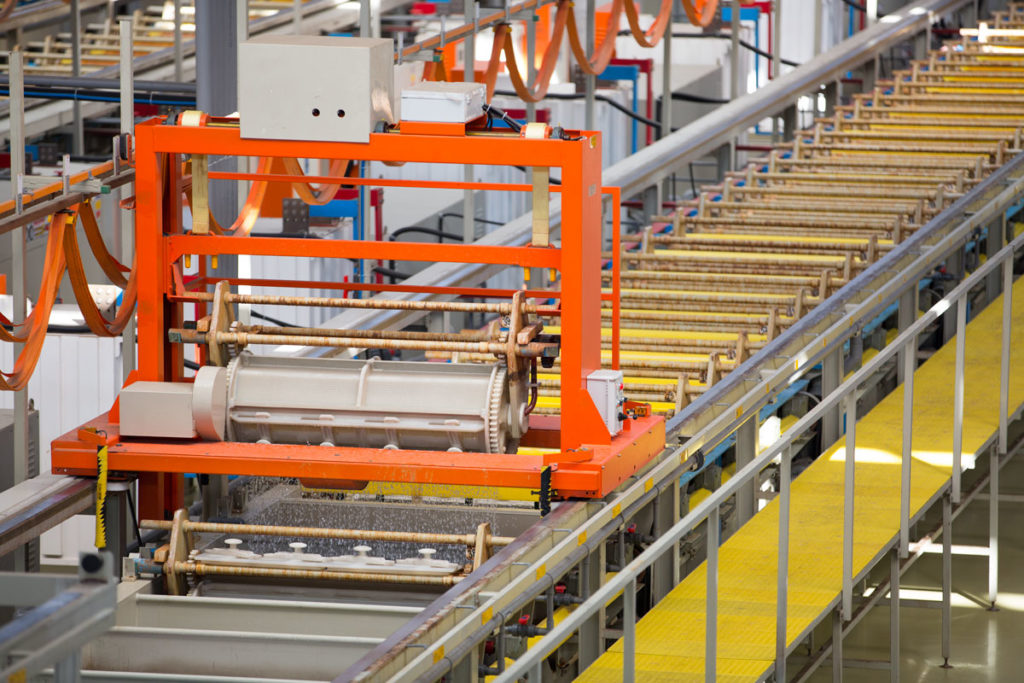Conversion means switching to another form, item, or state. In phosphate conversion coatings, the substrate involved in the metal coating reaction becomes a component of the coating. Phosphate conversion coatings are created from the surface of the base metal external.
Therefore, the porosity during the formation of the coating determines the thickness of the coating. The reaction stops after the surface has been cut off from the chemical solution.
Phosphate conversion coatings provide many important advantages, such as increasing corrosion resistance, absorbing oils, increasing the appearance, increasing adhesion and using resistance or facilitating cold forming.
The chemical process that converts the surface of the basemetal into a non-metallic crystal coating is called phosphating. The reaction takes place in an acidic solution containing phosphate ions. The hydrogen loss in the metal / solution interface results in a local increase in pH and subsequent deposition of the coating.
Phosphate coatings can be divided into three main types: zinc, manganese and iron. Different special formulations are available for each of them according to their functional requirements.
Heavy Zinc Phosphate
Heavy zinc phosphate is generally preferred in cases requiring retention of rust preventive oils and vaxes. The heavy coating, in the range of 1,000–3,000 mg/ft2, acts as an absorbent substrate, holding the rust preventive on the surface of the part.
Depending on the formulation and concentration of the rust inhibitor selected, orrosion protection of more than 400 hours of 5% neutral salt spray exposure is possible. Heavy zinc phosphate coatings are obtained by dipping. Parts are applied on shelves or drums.
The bath is initially charged at 3–4 percent by volume (30–40 total acid points) and operates at 175–185°F. The bath is controlled with simple
titrations that measure concentration (total acid), aggressiveness (free acid) and iron content.
Iron buildup is usually the limiting factor in the service life of the bath. When iron levels reach a higher level than zinc, coating quality and homogeneity are compromised. At this stage, a portion of the bath can be emptied or the bathroom can be filled fresh.
Calcium-Modified Zinc Phosphate
Calcium-modified zinc phosphate is generally used as a basis for paint or other organic coatings. Calcium deposited with zinc functions as a built-in refiner to form a smooth microcrystalline structure.
Coating weights are typically in the range of 150–500 mg/ft2, which allows for enhanced adhesion properties without being as absorptive as a heavy zinc phosphate coating. In addition, the chemical-resistant nature of calcium-modified zinc phosphate coatings confines corrosion to a limited area, often referred to as creepage, if the applied topcoat is damaged.
Calcium-modified zinc phosphates are often used prior to rubber bonding and also have wear-resistance. Calcium-modified zinc phosphate can be applied by spray or immersion. The bath is often a two-component system, with the calcium-rich component added upon start-up and infrequently thereafter.
Operating temperature is 150°F for spray and 170–180°F for immersion. Iron content contained in the bathroom may interfere with grain purification and non-uniform coatings may occur. Small amounts but a frequent addition of a strong oxidizer allows the iron to precipitate in solution and allow a long bath life.
Cold-Forming Zinc Phosphates
Cold-forming zinc phosphates are used to facilitate drawing, cold heading, stamping or extruding of the basis metal. These phosphate coatings are designed to hold lubricants in severe conditions of heat and pressure, which occur during deformation.
The use of the phosphate coating allows increased tool life, faster drawing speeds and more severe reductions of the basis metal. Coating weights for cold-forming zinc phosphates can range from 500–2,000 mg/ft2.
The phosphating solution in this application is operated iron-free to ensure a less abrasive zinc phosphate crystal, which will not scratch dies, score or gall. A strong oxidizer, usually nitrite or chlorate, is used to remove iron from the bath in the form of mud.
In addition, a titanium-based thinner pre-dip prior to phosphate may also be considered to obtain a softer and more homogeneous crystalline coating.





